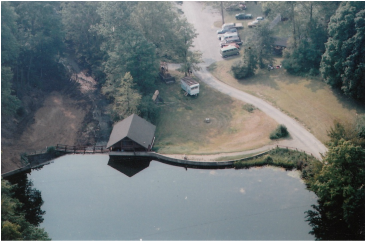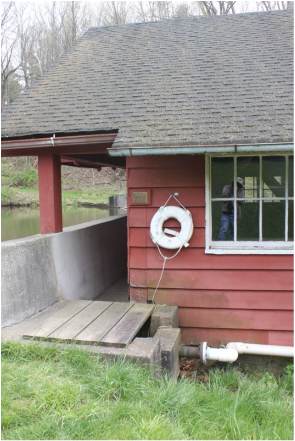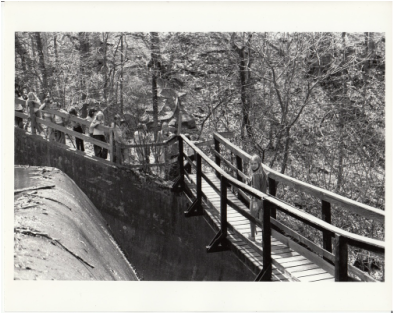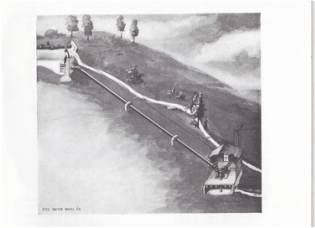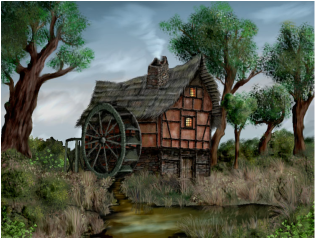The Mystery of Kirby's Mill and the Twisted Tale of Hydropower
originally published in the FoCHlore Blog on the RJRD website June 2016 copyright, Lynn Scholle Richardson
“Once you eliminate the impossible, whatever remains, no matter how improbable, must be the truth”
-Sir Arthur Conan Doyle
Kirby’s Mill is the most stand-out historic structure in Richfield Heritage Preserve at Crowell Hilaka. It’s a pretty thing; reflecting over the lake with its swinging bridge flung out like a graceful arm across the spillway. Sadly, the bridge is closed and the great water wheel is deteriorating. But happily, Friends of Crowell Hilaka was given permission to restore the mill last August. We began by researching the history and we found that as far as Kirby’s Mill is concerned; the more you know; the weirder it gets.
Kirby built his mill in 1922 to generate electricity for his home and workshop. He had made his fortune in Cleveland by inventing household appliances. Only 35 years old when he bought land in Richfield, he turned the old farm into a testing ground for his theories.
Once upon a time, a mill was just one piece of an ancient system for harnessing water power. The system also included a stream, a dam to create a millpond, and a millrace for getting water from the pond to the wheel. There was almost always a bridge nearby so people from both sides of the stream could get to the mill. Kirby experimented with every one of those elements. The lake was patented before it was even built. The dams being the key feature in the design. His use of ball bearings to support the axle of the waterwheel was a first.
But there are no blueprints or patents on the wheel or other mill features. When even the experts were puzzled by Kirby’s set up, we began to realize there might be more to the story.
It appears that the original millrace was also a new design. It ran under the mill so it wouldn’t freeze in winter. It was controlled with a value in the dam instead of a traditional gate. But the flow may have been a little too successful for the lightweight water wheel . A second, smaller millrace was positioned to snake around the mill and deliver a gentler flow.
I was SURE that the Girl Scouts had strung up that awkward-looking pipe around the outside of the mill; NOT the noble Mr. Kirby! But a closer look in the company of a millwright made it clear that the Girl Scouts weren’t the culprits. The current PVC pipe is new, but it connects to a valve inside a concrete box that is just about as old as the mill itself. Hence the quote at the beginning of this post. It certainly appears that Kirby was correcting a mistake. Once I wrapped my head around that concept, it wasn’t so bad. After all, the mill was an experiment. No one could have had previous experience with it. So if something didn’t go as planned…. he found a way to fix it.
We found that the swinging bridge was part of Kirby's original design. The cables holding it were set into the foundation of the mill, positioned so the surface of the lake would be at eye level when crossing.
But the strangest thing about the mill is the fact that it exists at all.
Kirby could have generated electricity much more easily with a small water-powered turbine. “Leslie’s”, a popular news magazine in Kirby’s time, published an article in 1913 on the growing trend of rural electrification using turbines. That was nine years before Kirby built his mill. Even if he hadn’t read that particular article, he surely would have been aware of the available technology.
Back in the day, the most common use of waterwheels had been for grist mills. But by 1900 almost all the surviving grist mills had traded in their grindstones for rollers and their wheels for turbines. Kirby could have made life much simpler for himself generating all the power he needed with a simple pre-manufactured turbine. But for some reason, he chose a different route.
My guess is that Kirby had a fondness for the old mills that dotted the countryside of his childhood and modeled his power station on one as soon as he had the chance. Back when he was fourteen years old, his teacher challenged him to build a model of a grist mill. Forty years later, he bragged, "It wasn’t much of a flour mill- but it worked!”.
We may never know if he thought his innovations might once again make water wheels a viable and wide-spread power source, or if he was re-building a dream .
My guess is that Kirby had a fondness for the old mills that dotted the countryside of his childhood and modeled his power station on one as soon as he had the chance. Back when he was fourteen years old, his teacher challenged him to build a model of a grist mill. Forty years later, he bragged, "It wasn’t much of a flour mill- but it worked!”.
We may never know if he thought his innovations might once again make water wheels a viable and wide-spread power source, or if he was re-building a dream .



